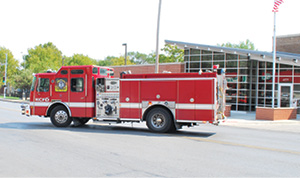
By LESLIE COLLINS
Northeast News
November 6, 2013
“We’re improving, but we’re not where we want to be,” Kansas City Fire Department (KCFD) Chief Paul Berardi said of the ambulance response times.
During the month of September, ambulance response times increased across the board in the four ambulance response districts (ARD).
KCFD Deputy Chief Tom Collins said the longer response times was due to two factors: a lower call volume – creating a smaller sample size for averaging data – and an uptick in multiple calls for service coming in simultaneously from the same geographical area. This put multiple units out on calls at the same time, limiting resources for other incoming calls.
City ordinance requires that ambulances respond to life threatening emergencies in 9 minutes or less 85 percent of the time in each ambulance district and in 9 minutes or less citywide 90 percent of the time.
In September, KCFD responded to life threatening emergencies within 9 minutes or less 70.7 percent of the time in ARD 1 (Northland); 84.3 percent of the time in ARD 2 (Central); 79 percent in ARD 3 (East side); and 70.3 percent in ARD 4 (South side). Citywide, KCFD met the requirement 77.2 percent of the time. Response times not meeting the goal ranged from 9:03 minutes to 13:34 minutes.
For the three month average, ARD 1 met the goal 71.7 percent of the time; ARD 2, 86.2 percent; ARD 3, 79.8 percent; ARD 4, 70.8 percent.
One initiative expected to improve response times includes hiring additional paramedics. KCFD will soon hire 13 additional paramedics to fill the department’s paramedic vacancies. Currently, the department has 108 paramedics staffed on ambulances and 43 paramedics staffed on fire suppression units. Throughout the city, KCFD uses 22 static ambulances which must be staffed with one paramedic and one emergency medical technician (EMT). If a paramedic isn’t available for an ambulance shift, then that ambulance can’t operate, Collins said.
“Having the extra people to fill those spots will help us keep the ambulances we need on the streets,” Collins said.
Another initiative expected to improve ambulance response times is the advanced life support (ALS) pumper program, which will be implemented by Dec. 15. An ALS pumper will be added to fire stations located at 111th and Oak, 80th and Oak and Bannister and Hillcrest. Locations were determined by demand and gaps in service, Berardi said. KCFD also hopes to add ALS pumpers to additional locations in the future, he said. ALS pumpers will be staffed with four people, including one paramedic, and are equipped with advanced life support equipment. An ALS pumper can provide the same care to a patient as an ambulance; the only difference is the pumper can’t transport a patient.
KCFD is also in the process of developing a strategic plan which will review the ambulance service, paradigms and goals, among other items. Berardi said the plan should be completed by March.















